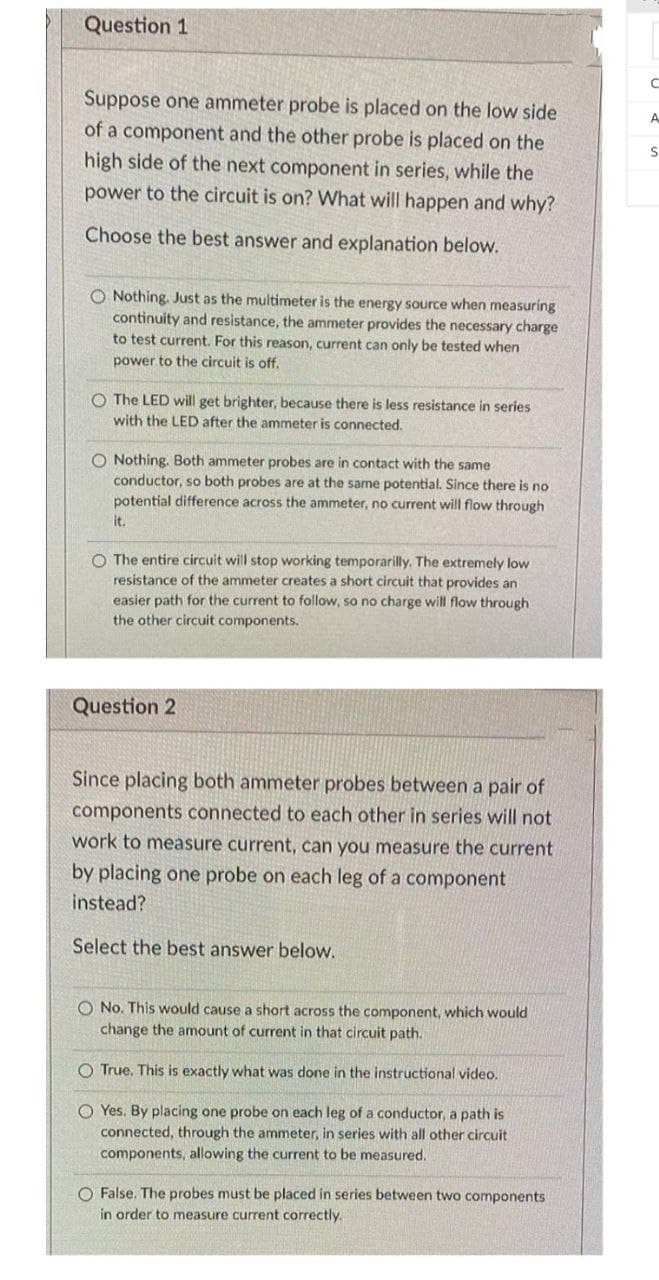Suppose one ammeter probe is placed on the low side of a component and the other probe is placed on the high side of the next component in series, while the power to the circuit is on? What will happen and why? Choose the best answer and explanation below. O Nothing. Just as the multimeter is the energy source when measuring continuity and resistance, the ammeter provides the necessary charge to test current. For this reason, current can only be tested when power to the circuit is off. O The LED will get brighter, because there is less resistance in series with the LED after the ammeter is connected. O Nothing. Both ammeter probes are in contact with the same conductor, so both probes are at the same potential. Since there is no potential difference across the ammeter, no current will flow through it. O The entire circuit will stop working temporarilly. The extremely low resistance of the ammeter creates a short circuit that provides an easier path for the current to follow, so no charge will flow through the other circuit components.
Suppose one ammeter probe is placed on the low side of a component and the other probe is placed on the high side of the next component in series, while the power to the circuit is on? What will happen and why? Choose the best answer and explanation below. O Nothing. Just as the multimeter is the energy source when measuring continuity and resistance, the ammeter provides the necessary charge to test current. For this reason, current can only be tested when power to the circuit is off. O The LED will get brighter, because there is less resistance in series with the LED after the ammeter is connected. O Nothing. Both ammeter probes are in contact with the same conductor, so both probes are at the same potential. Since there is no potential difference across the ammeter, no current will flow through it. O The entire circuit will stop working temporarilly. The extremely low resistance of the ammeter creates a short circuit that provides an easier path for the current to follow, so no charge will flow through the other circuit components.
Delmar's Standard Textbook Of Electricity
7th Edition
ISBN:9781337900348
Author:Stephen L. Herman
Publisher:Stephen L. Herman
Chapter17: Resistive-inductive Series Circuits
Section: Chapter Questions
Problem 1PA: An AC electric motor is connected to a 240-V, 60-Hz source. A clamp-on ammeter with a peak hold...
Related questions
Question

Transcribed Image Text:Question 1
Suppose one ammeter probe is placed on the low side
of a component and the other probe is placed on the
high side of the next component in series, while the
A
power to the circuit is on? What will happen and why?
Choose the best answer and explanation below.
O Nothing. Just as the multimeter is the energy source when measuring
continuity and resistance, the ammeter provides the necessary charge
to test current. For this reason, current can only be tested when
power to the circuit is off.
O The LED will get brighter, because there is less resistance in series
with the LED after the ammeter is connected.
O Nothing. Both ammeter probes are in contact with the same
conductor, so both probes are at the same potential. Since there is no
potential difference across the ammeter, no current will flow through
it.
O The entire circuit will stop working temporarilly. The extremely low
resistance of the ammeter creates a short circuit that provides an
easier path for the current to follow, so no charge will flow through
the other circuit components.
Question 2
Since placing both ammeter probes between a pair of
components connected to each other in series will not
work to measure current, can you measure the current
by placing one probe on each leg of a component
instead?
Select the best answer below.
O No. This would cause a short across the component, which would
change the amount of current in that circuit path.
O True. This is exactly what was done in the instructional video.
O Yes. By placing one probe on each leg of a conductor, a path is
connected, through the ammeter, in series with all other circuit
components, allowing the current to be measured.
O False. The probes must be placed in series between two components
in order to measure current correctly.
Expert Solution
This question has been solved!
Explore an expertly crafted, step-by-step solution for a thorough understanding of key concepts.
This is a popular solution!
Trending now
This is a popular solution!
Step by step
Solved in 2 steps

Knowledge Booster
Learn more about
Need a deep-dive on the concept behind this application? Look no further. Learn more about this topic, electrical-engineering and related others by exploring similar questions and additional content below.Recommended textbooks for you

Delmar's Standard Textbook Of Electricity
Electrical Engineering
ISBN:
9781337900348
Author:
Stephen L. Herman
Publisher:
Cengage Learning

EBK ELECTRICAL WIRING RESIDENTIAL
Electrical Engineering
ISBN:
9781337516549
Author:
Simmons
Publisher:
CENGAGE LEARNING - CONSIGNMENT

Delmar's Standard Textbook Of Electricity
Electrical Engineering
ISBN:
9781337900348
Author:
Stephen L. Herman
Publisher:
Cengage Learning

EBK ELECTRICAL WIRING RESIDENTIAL
Electrical Engineering
ISBN:
9781337516549
Author:
Simmons
Publisher:
CENGAGE LEARNING - CONSIGNMENT